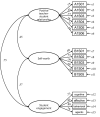Self-Worth as a Mediator and Moderator Between Teacher-Student Relationships and Student Engagement in Rural Schools
- PMID: 35145453
- PMCID: PMC8824259
- DOI: 10.3389/fpsyg.2021.777937
Self-Worth as a Mediator and Moderator Between Teacher-Student Relationships and Student Engagement in Rural Schools
Abstract
This study examined how self-worth of students mediated and moderated their perceived positive teacher-student relationships and student engagement among middle-school students from rural China. Eighth graders (N = 838) completed surveys measuring their perceived relationships with teachers, their self-worth, and engagement. Statistical analyses revealed significant correlations among all three variables, with the strongest being between teacher-student relationships and student engagement. The structural equation modeling indicated that self-worth partially mediated the effect of teacher-student relationships on student engagement; however, positive teacher-student relationships were a stronger predictor. Multigroup analyses identified self-worth as a moderator, whereby students with lower self-worth were more reliant on positive teacher-student relationships to enhance their engagement. This study provides insights into how self-worth of students and their perceived positive teacher-student relationships influence their academic engagement in disadvantaged rural areas of China.
Keywords: rural schools; self-worth; student engagement; student learning; teacher-student relationships.
Copyright © 2022 Huang, Sang and Chao.
Conflict of interest statement
The authors declare that the research was conducted in the absence of any commercial or financial relationships that could be construed as a potential conflict of interest.
Figures
References
-
- Brinkworth M. E., McIntyre J., Juraschek A. D., Gehlbach H. (2017). Teacher-student relationships: the positives and negatives of assessing both perspectives. J. Appl. Dev. Psychol. 55 24–38.
-
- Brown J. D., Brown M. A. (2011). Self-reflection and feelings of self-worth: When Rosenberg meets Heisenberg. J. Exp. Soc. Psychol. 47 1269–1275. 10.1016/j.jesp.2011.05.019 - DOI
-
- Chen G., Zhang J., Chan K., Michaels S., Resnick L. B., Huang X. (2020). The link between student-perceived teacher talk and student enjoyment, anxiety and discursive engagement in the classroom. Br. Educ. Res. J. 46 631–652.
LinkOut - more resources
Full Text Sources




